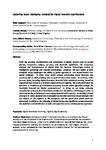Rationing bytes: managing demand for digital forensic examinations
| dc.contributor.author | Rappert, B | |
| dc.contributor.author | Wheat, Hannah | |
| dc.contributor.author | Wilson-Kovacs, D | |
| dc.date.accessioned | 2020-08-04T10:43:11Z | |
| dc.date.available | 2020-08-04T10:43:11Z | |
| dc.date.issued | 2020-07-01 | |
| dc.identifier.issn | 1043-9463 | |
| dc.identifier.issn | 1477-2728 | |
| dc.identifier.uri | http://hdl.handle.net/10026.1/16130 | |
| dc.description | 18 months embargo | |
| dc.description.abstract |
With the growing sophistication and prevalence of digital devices such as mobile phones, computers, tablets, sat-navs, and domestic appliances, the extraction, analysis and interpretation of digital data has become increasingly central to intelligence gathering and criminal proceedings. However, the very extent of data available today challenges the ability of police agencies to turn seized devices into useful evidence. To date, most social science scholarship about forensics has concentrated on DNA profiling and its societal and ethical issues. In contrast, other forensic fields, including digital forensics, have had little analytical scrutiny. Based on unprecedented access to a forensic collaboration in England, this study addresses the question: In conditions of constrained resources, how do police agencies manage the insatiable demand for digital examinations? In doing so, we bring rationing classification schemes from healthcare studies into the field of criminology in order to characterise the techniques for reconciling demand with capacity. As detailed, formal attempts to ration demand are confounded by informal practices and procedures that can impact on the capacity of the workforce and the speed with which cases are processed. In addition, the rationing of digital devices has significant consequences for the definition and distribution of skills and expertise across criminal justice agencies. | |
| dc.format.extent | 1-14 | |
| dc.language | en | |
| dc.language.iso | en | |
| dc.publisher | Informa UK Limited | |
| dc.subject | Digital forensics | |
| dc.subject | rationing | |
| dc.subject | England | |
| dc.subject | digital policing | |
| dc.title | Rationing bytes: managing demand for digital forensic examinations | |
| dc.type | journal-article | |
| dc.type | Journal Article | |
| plymouth.author-url | https://www.webofscience.com/api/gateway?GWVersion=2&SrcApp=PARTNER_APP&SrcAuth=LinksAMR&KeyUT=WOS:000547672800001&DestLinkType=FullRecord&DestApp=ALL_WOS&UsrCustomerID=11bb513d99f797142bcfeffcc58ea008 | |
| plymouth.issue | 1 | |
| plymouth.volume | 31 | |
| plymouth.publication-status | Published | |
| plymouth.journal | Policing and Society | |
| dc.identifier.doi | 10.1080/10439463.2020.1788026 | |
| plymouth.organisational-group | /Plymouth | |
| plymouth.organisational-group | /Plymouth/Faculty of Health | |
| plymouth.organisational-group | /Plymouth/Faculty of Health/Peninsula Medical School | |
| plymouth.organisational-group | /Plymouth/Research Groups | |
| plymouth.organisational-group | /Plymouth/Research Groups/FoH - Community and Primary Care | |
| plymouth.organisational-group | /Plymouth/Users by role | |
| plymouth.organisational-group | /Plymouth/Users by role/Academics | |
| dcterms.dateAccepted | 2020-06-19 | |
| dc.rights.embargodate | 2022-1-1 | |
| dc.identifier.eissn | 1477-2728 | |
| dc.rights.embargoperiod | Not known | |
| rioxxterms.versionofrecord | 10.1080/10439463.2020.1788026 | |
| rioxxterms.licenseref.uri | http://www.rioxx.net/licenses/all-rights-reserved | |
| rioxxterms.licenseref.startdate | 2020-07-01 | |
| rioxxterms.type | Journal Article/Review |


